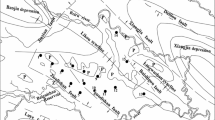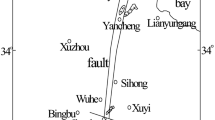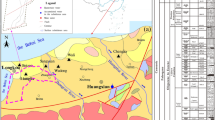Abstract
To explore the controlling factors of the hydrochemistry and hydraulic connections of groundwater in three mining districts, 45 water samples from three mining districts (Nos. 31, 32 and 42) in the Peigou Coal Mine are analyzed. The hydrogeochemical compositions of the three mining districts are analyzed, and the water–rock interaction and controlling factors of the hydrogeochemistry of the groundwater are discussed by examining the ionic composition (ion ratio) and using a factor analysis. Then, the hydraulic connection is determined by conducting cluster and discriminant analyses. Finally, a model that identifies the source of the water inrush of the three mining districts is provided. The results show the controlling factors of the hydrogeochemistry in the three mining districts. And it is speculated that the hydraulic connection between the Nos. 31 and 42 mining districts is higher than that between the Nos. 31 and 32 mining districts. It is hypothesized that there may be an obscured tunnel between the Nos. 31 and 42 mining districts, which is connected through the Fushanzhai fault. Based on the water source identification model of mining districts, the groundwater recharge relationship of three mining districts is inverted by analyzing the causes of misjudgment and comparing with groundwater pulse in different years. The proposed method provides a new idea for correctly recognizing the groundwater circulation conditions under the influence of mining.










Similar content being viewed by others
References
Chen S, Gui HR (2017) Hydrogeochemical characteristics of groundwater in the coal-bearing aquifer of the Wugou coal mine, northern Anhui province, China. Appl Water Sci 7(4):1903–1910
Dong DL, Sun WJ, Xi S (2012) Water-inrush assessment using a GIS-based Bayesian network for the 12-2 coal seam of the Kailuan Donghuantuo coal mine in China. Mine Water Environ 31(2):138–146
Drollette BD, Hoelzer K, Warner NR et al (2015) Elevated levels of diesel range organic compounds in groundwater near Marcellus gas operations are derived from surface activities. Proc Natl A Sci India A 112(43):13184–13189
Gao R, Yan H, Ju F et al (2018) Influential factors and control of water inrush in a coal seam as the main aquifer. Int J Min Sci Technol 28(2):187–193
Gui HR, Lin ML (2016) Types of water hazards in China coalmines and regional characteristics. Nat Hazards 84(2):1501–1512
Gui HR, Lin ML, Song XM (2017) Features of separation water hazard in China coalmines. Water Pract Technol 12(1):146–155
Gurarslan G, Karahan H (2015) Solving inverse problems of groundwater-pollution-source identification using a differential evolution algorithm. Hydrogeol J 23(6):1109–1119
Helstrup T, Jorgensen NO, Banoeng-Yakubo B (2007) Investigation of hydrochemical characteristics of groundwater from the cretaceous-eocene limestone aquifer in southern Ghana and southern Togo using hierarchical cluster analysis. Hydrogeol J 15(5):977–989
Ismail A, Toriman ME, Juahir H, Zain SM et al (2016) Spatial assessment and source identification of heavy metals pollution in surface water using several chemometric techniques. Mar Pollut Bull 106(1–2):292–300
LaMoreaux JW, Wu Q, Zhou WF (2014) New development in theory and practice in mine water control in China. Carbonate Evaporite 29(2):141–145
Lei M, Qian JZ, Zhao WD (2014) An approach for quickly identifying water-inrush source of mine based on GIS and groundwater chemistry and temperature. Coal Geol Explor 42(2):49–53
Li PY, Wu JH, Tian R et al (2018) Geochemistry, hydraulic connectivity and quality appraisal of multilayered groundwater in the Hongdunzi coal mine, Northwest China. Mine Water Environ 37(2):222–237
Odintsev VN, Miletenko NA (2015) Water inrush in mines as a consequence of spontaneous hydrofracture. J Min Sci 51(3):423–434
Qaisar FUR, Zhang F, Pant RR et al (2018) Spatial variation, source identification, and quality assessment of surface water geochemical composition in the Indus River Basin, Pakistan. Environ Sci Pollut R 25(5):1–15
Qian JZ, Tong Y, Ma L et al (2018) Hydrochemical characteristics and groundwater source identification of a multiple aquifer system in a coal mine. Mine Water Environ 37(3):528–540
Sammarco O, Eng D (1986) Spontaneous inrushes of water in underground mines. Int J Mine Water 5(3):29–41
Sun LH (2014) Statistical analysis of hydrochemistry of groundwater and its implications for water source identification: a case study. Arab J Geosci 7(9):3417–3425
Sun LH (2017) Statistical analyses of groundwater chemistry in coalmine and its hydrological implications. J Appl Sci Eng 20(3):335–344
Sun LH, Chen S, Gui HR (2016) Source identification of inrush water based on groundwater hydrochemistry and statistical analysis. Water Pract Technol 11(2):448–458
Sun CY, Zhang JQ, Ma QY et al (2017a) Polycyclic aromatic hydrocarbons (PAHs) in water and sediment from a river basin: sediment–water partitioning, source identification and environmental health risk assessment. Environ Geochem Health 39(1):63–74
Sun J, Hu Y, Zhao G (2017b) Relationship between water inrush from coal seam floors and main roof weighting. Int J Min Sci Technol 27(5):873–881
Wang Y, Zhou MR, Yan PC et al (2017a) Identification of coalmine water inrush source with PCA-BP model based on laser-induced fluorescence technology. Spectrosc Spectr Anal 37(3):978–983
Wang Y, Zhou MR, Yan PC et al (2017b) Rapid identification model of mine water inrush sources based on extreme learning machine. Int J Wirel Mob Comput 13(4):286–290
Wu Q, Liu YZ, Luo LH et al (2015) Quantitative evaluation and prediction of water inrush vulnerability from aquifers overlying coal seams in Donghuantuo coal mine, China. Environ Earth Sci 74(2):1429–1437
Acknowledgements
This research is supported by the Fundamental Research Funds for the Central Universities (2017XKQY057) and the Priority Academic Program Development of Jiangsu Higher Education Institutions (PAPD). The authors are grateful to the anonymous reviewers for their helpful comments on the manuscript.
Author information
Authors and Affiliations
Corresponding author
Additional information
Publisher's Note
Springer Nature remains neutral with regard to jurisdictional claims in published maps and institutional affiliations.
Rights and permissions
About this article
Cite this article
Chen, Y., Zhu, S. & Xiao, S. Discussion on controlling factors of hydrogeochemistry and hydraulic connections of groundwater in different mining districts. Nat Hazards 99, 689–704 (2019). https://doi.org/10.1007/s11069-019-03767-1
Received:
Accepted:
Published:
Issue Date:
DOI: https://doi.org/10.1007/s11069-019-03767-1




